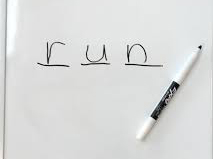Does your child sound out words fairly accurately only to then struggle to ‘blend’ the sounds together in order to read the word accurately? Examples of this might sound like “t..e..n…….top” or “s…i…t…..tea”.
Sometimes a child will accurately sound out a word but then guess a word inaccurately that might start or end with a sound or letter in the target word. On other occasions your child might look to the picture to then substitute a word that might make sense to them in the context of the sentence. Neither of these strategies, and I repeat, NEITHER OF THESE STRATEGIES are those used by good readers to decode and read words fluently. We must teach our children effective decoding reading strategies if we are to build strong reading skills and help our children engage with written texts.
We have plenty of children on our caseload who sound just like this when the first present to us in the Learn2Communicate clinic. Sure, we are delighted that they are at least trying to decode the word using phonic decoding skills i.e. by sounding out. The problem can be that these children often get stuck at this first step and some struggle to eventually become fluent word readers. These difficulties are only exacerbated when children are exposed to words within sentences and sentences within longer texts such as home readers. Eeek! It just becomes all too tempting to fall into those quick and easy but ineffective strategies to ‘guess’ versus ‘read’ the word.
Luckily we have some ideas to help you gently nudge and support your children from sounding out words in a disjointed sound by sound manner to reading words with greater fluency and ease.
Start with words that have 3 sounds but make sure that the first consonant is a long or continuant sound. Sounds such as /s z sh f m n l v/ are all suitable. Words that you can use include: sap sit sun sud zip zap shop ship shin sham fad fin fat fun man mop mud nod not lot lip let log van and vet.

Grab yourself a small white board and write one of these words saying the sounds as you write each letter. This will model to your child how we map or glue speech sounds to letters on the page when spelling. Use large lower case handwriting for this activity.
Help your child to then say the sounds as you drag your finger under each letter. Try to ‘stretch’ out the first sound to help it connect to the vowel sound that follows. By stretching as opposed to jumping out the sounds in a disjointed manner, your child will be more likely to hear the word in their head particularly if the word is already in his or her vocabulary. Teaching your child to stretch out sounds in this way is far more effective if you start with words that have long sounds versus short sounds at the beginning.
If your child is continuing to experience difficulty, we find that these lovely short vowel word family booklets are very helpful. They assist your child to sound out words in what we refer to as onset + rime chunks e.g. sh-op, ch-op, c-op and fl-op. We love these little booklets that focus on word lists and simple decodable phrases using the target words.
Spending time developing ease and fluency at single word and short phrase level is really worth your time and will assist in building the foundations for effective reading skills. Once your child is ready to jump into text, start with these terrific readers to boost confidence and ability.
Best of luck in supporting your child’s early reading skills. Remember to let us know if these tips were helpful or if you have any other questions that you would like answers for when it comes to your child’s speech, language, communication and literacy development.





